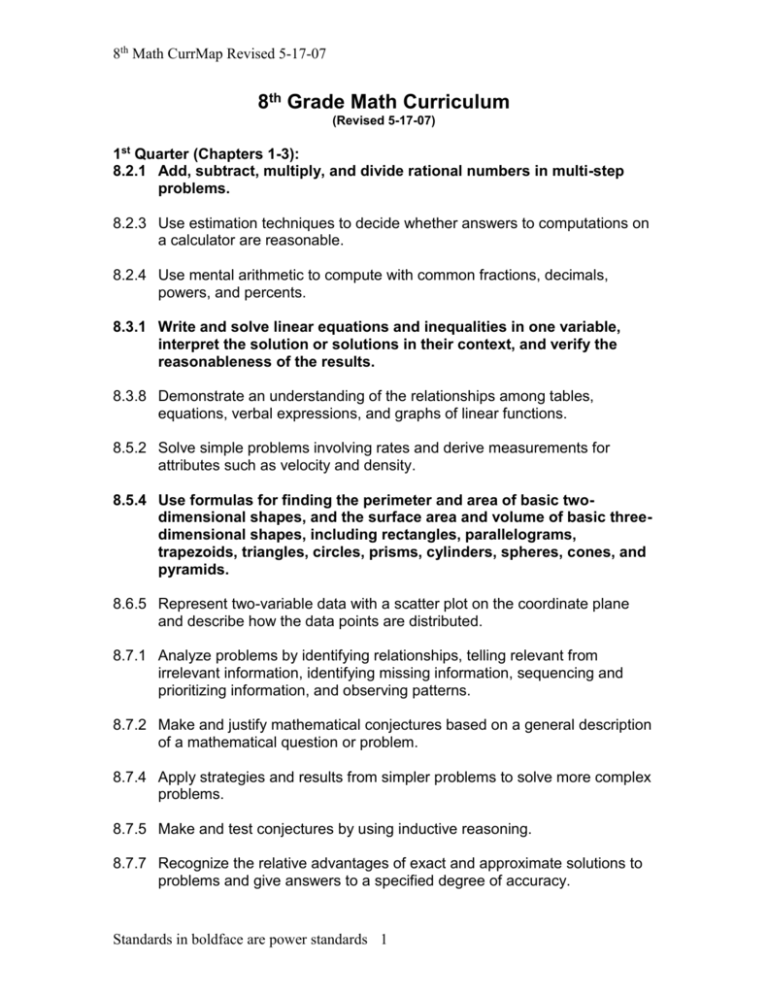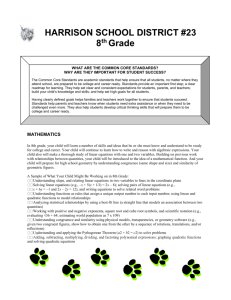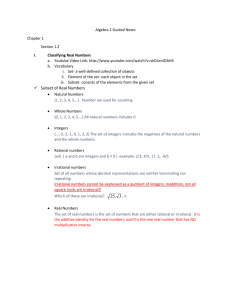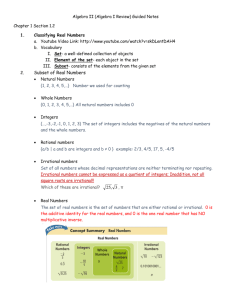Curriculum Mapping
advertisement

8th Math CurrMap Revised 5-17-07 8th Grade Math Curriculum (Revised 5-17-07) 1st Quarter (Chapters 1-3): 8.2.1 Add, subtract, multiply, and divide rational numbers in multi-step problems. 8.2.3 Use estimation techniques to decide whether answers to computations on a calculator are reasonable. 8.2.4 Use mental arithmetic to compute with common fractions, decimals, powers, and percents. 8.3.1 Write and solve linear equations and inequalities in one variable, interpret the solution or solutions in their context, and verify the reasonableness of the results. 8.3.8 Demonstrate an understanding of the relationships among tables, equations, verbal expressions, and graphs of linear functions. 8.5.2 Solve simple problems involving rates and derive measurements for attributes such as velocity and density. 8.5.4 Use formulas for finding the perimeter and area of basic twodimensional shapes, and the surface area and volume of basic threedimensional shapes, including rectangles, parallelograms, trapezoids, triangles, circles, prisms, cylinders, spheres, cones, and pyramids. 8.6.5 Represent two-variable data with a scatter plot on the coordinate plane and describe how the data points are distributed. 8.7.1 Analyze problems by identifying relationships, telling relevant from irrelevant information, identifying missing information, sequencing and prioritizing information, and observing patterns. 8.7.2 Make and justify mathematical conjectures based on a general description of a mathematical question or problem. 8.7.4 Apply strategies and results from simpler problems to solve more complex problems. 8.7.5 Make and test conjectures by using inductive reasoning. 8.7.7 Recognize the relative advantages of exact and approximate solutions to problems and give answers to a specified degree of accuracy. Standards in boldface are power standards 1 8th Math CurrMap Revised 5-17-07 8.7.8 Select and apply appropriate methods for estimating results of rationalnumber computations. 8.7.10 Make precise calculations and check the validity of the results in the context of the problem. 8.7.11 Decide whether a solution is reasonable in the context of the original situation. 2nd Quarter (Chapters 4, 5, & 6 thru Lesson 6-3): 8.1.1 Read, write, compare, and solve problems using decimals in scientific notation. 8.1.2 Know that every rational number is either a terminating or repeating decimal and that every irrational number is a non-repeating decimal. 8.1.4 Understand and evaluate negative integer exponents. 8.1.5 Use the laws of exponents for integer exponents. 8.2.1 Add, subtract, multiply, and divide rational numbers in multi-step problems. 8.3.1 Write and solve linear equations and inequalities in one variable, interpret the solution or solutions in their context, and verify the reasonableness of the results. 8.3.3 Interpret positive integer powers as repeated multiplication and negative integer powers as repeated division or multiplication by the multiplicative inverse. 8.3.4 Use the correct order of operations to find the values of algebraic expressions involving powers. 8.5.1 Convert common measurements for length, area, volume, weight, capacity, and time to equivalent measurements within the same system. 8.5.3 Solve problems involving scale factors, area, and volume using ratio and proportion. 8.6.1 Identify claims based on statistical data and, in simple cases, evaluate the reasonableness of the claims. 8.6.2 Identify different methods of selecting samples, analyzing the strengths and weaknesses of each method, and the possible bias in a sample or display. Standards in boldface are power standards 2 8th Math CurrMap Revised 5-17-07 8.6.3 Understand the meaning of, and be able to identify or compute the minimum value, the lower quartile, the median, the upper quartile, the interquartile range, and the maximum value of a data set. 8.7.1 Analyze problems by identifying relationships, telling relevant from irrelevant information, identifying missing information, sequencing and prioritizing information, and observing patterns. 8.7.2 Make and justify mathematical conjectures based on a general description of a mathematical question or problem. 8.7.4 Apply strategies and results from simpler problems to solve more complex problems. 8.7.6 Express solutions clearly and logically by using the appropriate mathematical terms and notation. 8.7.8 Select and apply appropriate methods for estimating results of rationalnumber computations. 8.7.12 Note the method of finding the solution and show a conceptual understanding of the method by solving similar problems. 3rd Quarter (Chapters 6 Lessons 6-4 thru 6-9, 7, and 8 thru Lesson 8-7) 8.2.2 Solve problems by computing simple and compound interest. 8.2.4 Use mental arithmetic to compute with common fractions, decimals, powers, and percents. 8.3.1 Write and solve linear equations and inequalities in one variable, interpret the solution or solutions in their context, and verify the reasonableness of the results. 8.3.5 Identify and graph linear functions and identify lines with positive and negative slope. 8.3.6 Find the slope of a linear function given the equation and write the equation of a line given the slope and any point on the line. 8.3.7 Demonstrate an understanding of rate as a measure of one quantity with respect to another quantity. 8.3.8 Demonstrate an understanding of the relationships among tables, equations, verbal expressions, and graphs of linear functions. Standards in boldface are power standards 3 8th Math CurrMap Revised 5-17-07 8.6.1 Identify claims based on statistical data and, in simple cases, evaluate the reasonableness of the claims. 8.6.2 Identify different methods of selecting samples, analyzing the strengths and weaknesses of each method, and the possible bias in a sample or display. 8.6.6 Understand and recognize equally likely events. 4th Quarter (Lessons 8-9 & 8-10, Chapters 9, 10, and parts of 11 & 12) 8.1.2 Know that every rational number is either a terminating or repeating decimal and that every irrational number is a non-repeating decimal. 8.1.3 Understand that computations with an irrational number and a rational number produce an irrational number. 8.1.6 Use the inverse relationship between squaring and finding the square root of a perfect square integer. 8.1.7 Calculate and find approximations of square roots. 8.2.1 Add, subtract, multiply, and divide rational numbers in multi-step problems. 8.3.2 Solve systems of two linear equations using the substitution method and identify approximate solutions graphically. 8.4.1 Identify and describe basic properties of geometric shapes; altitudes, diagonals, angle and perpendicular bisectors, central angels, radii, diameters, and chords. 8.4.2 Perform simple constructions, such as bisectors of segments and angles, copies of segments and angles, and perpendicular segments. 8.4.4 Draw the translation, rotation, reflection, and dilation of shapes. 8.4.5 Use the Pythagorean Theorem and its converse to solve problems in two and three dimensions. 8.5.3 Solve problems involving scale factors, area, and volume using ratio and proportion. Standards in boldface are power standards 4 8th Math CurrMap Revised 5-17-07 8.5.4 Use formulas for finding the perimeter and area of basic twodimensional shapes, and the surface area and volume of basic threedimensional shapes, including rectangles, parallelograms, trapezoids, triangles, circles, prisms, cylinders, spheres, cones, and pyramids. 8.5.5 Estimate and compute the area and volume of irregular two- and threedimensional shapes by breaking the shapes down into more basic geometric objects. 8.6.3 Understand the meaning of, and be able to identify or compute the minimum value, the lower quartile, the median, the upper quartile, the interquartile range, and the maximum value of a data set. 8.6.6 Understand and recognize equally likely events. 8.6.7 Find the number of possible arrangements of several objects by using the Basic Counting Principle. 8.7.9 Use graphing to estimate solutions and check the estimates with analytic approaches. 8.7.11 Decide whether a solution is reasonable in the context of the original situation. Standards in boldface are power standards 5








